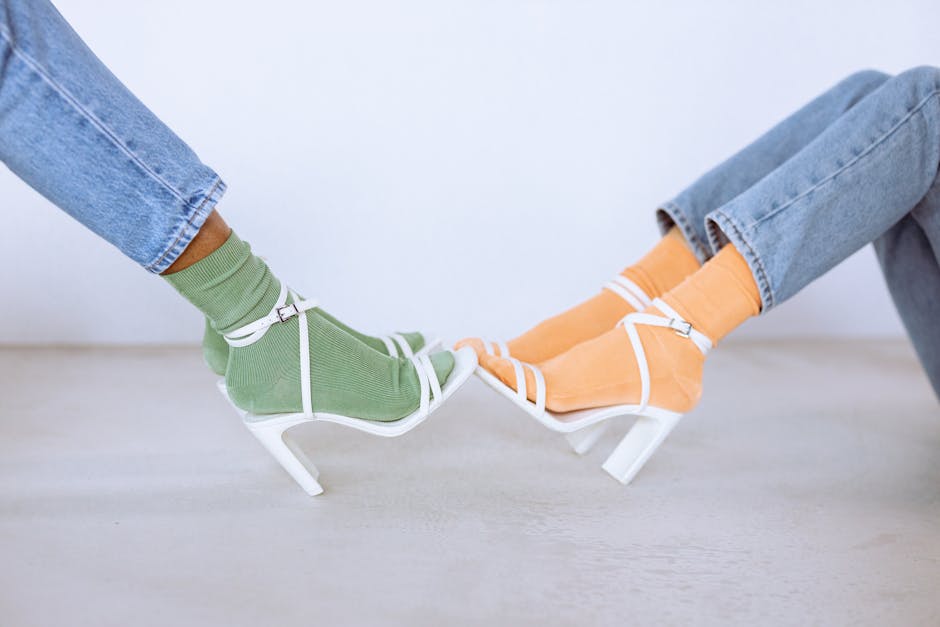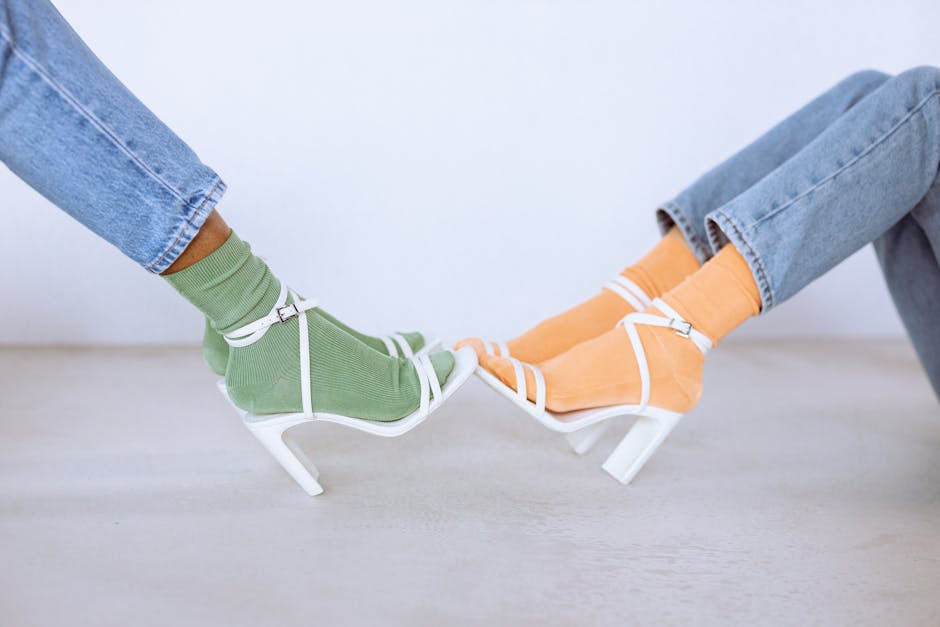The Origins of Women’s Heels: A Functional Beginning
The story of women’s heels starts with a twist: they weren’t originally designed for women at all. Believe it or not, heels came into play for Persian cavalrymen around the 10th century. The idea was practical — heels helped keep a rider’s foot secure in stirrups, ensuring better stability while shooting arrows. When this trend galloped into Europe, heels became a symbol of status and power among men. It wasn’t until the 16th century that women started adopting heels, initially to mimic men’s fashion and project an air of authority and high status. This marked the beginning of heels transitioning from a functional piece of horse-riding equipment to a staple in women’s fashion. So, the next time you slip on a pair of heels, remember it’s not just about fashion; it’s a centuries-old practice of borrowing from men’s style playbook to express power and prestige.
The Renaissance Era: Heels as a Status Symbol
During the Renaissance, heels weren’t just a fashion statement; they were a loud and clear announcement of one’s social status. Back then, fancy footwear, especially heels, was a privilege of the wealthy and the powerful. It started in the 15th century when European nobles began wearing them. Why? Because heels made them look taller, more commanding, and, in a way, above everyone else—literally. But it wasn’t all about looking authoritative. Heels were also practical for horse riding. They helped keep a rider’s feet in the stirrups, making for a safer and more efficient ride. So, if you saw someone strutting around in heels, it meant they were someone of importance and probably spent a good amount of time on horseback. No surprise then, the higher the heels, the higher the status. This trend wasn’t limited to men or women; it was a unisex fashion statement among the elite. Over time, as political dynamics changed, so did the symbolism attached to heels, but during the Renaissance, they were definitely more than just shoes. They were a symbol of power and prestige.
17th and 18th Centuries: Heels in Men’s and Women’s Fashion
Back in the 17th and 18th centuries, heels weren’t just for women. Men wore them too, especially the high-class folks. It all started with Persian cavalrymen. They wore heels to help keep their feet in stirrups while riding horses. When this trend hit Europe, everybody wanted in on the action. Heels became a symbol of nobility, power, and military prowess. But, as the 18th century rolled around, things began to shift. Women’s heels got more intricate and decorative, while men’s heels were on their way out. This era brought the birth of heels as a primarily feminine fashion statement. We’re talking about heels becoming slimmer, taller, and all about adding to a woman’s elegance and posture. So, next time you slip into a pair of heels, remember, it’s not just fashion; it’s history on your feet.
The 19th Century: The Demise and Resurgence of Heels
In the 19th century, heels took a backseat. Society leaned more towards practical and comfortable footwear, especially for women. Most ladies ditched heels for flats, as the era celebrated functionality over flashy fashion. But, like all good trends, heels made a strong comeback. By the mid to late 1800s, technology and fashion interests aligned, sparking the resurgence of women’s heels. This time, heels weren’t just about status or avoiding street muck. They were about expressing femininity and elegance. Innovations in shoe production made heels more available and comfortable, leading more women to adopt them into their wardrobes. The revival wasn’t just about height; it was about making a statement, with designs that matched the elaborate fashions of the period. So, heels walked their way back into the spotlight, thanks to a blend of technological advances and changing fashion tastes.
Early 20th Century: Heels and the Flapper Movement
In the early 20th century, women’s heels took a bold leap with the flapper movement. This era wasn’t just about challenging social norms; it was also about fashion making a statement. Flappers ditched the tight corsets and opted for loose, flowing dresses. And yes, they stepped up their game with heels. These weren’t just any heels; they were lower, comfortable, but still stylish – perfect for dancing the Charleston or showing off in speakeasies. The heels of this time reflected the rebellious spirit of the women who wore them. They were a symbol of freedom and self-expression. It was during this time that heels started becoming a staple in women’s fashion, moving beyond just function. They symbolized a new era of women taking control not only of their fashion choices but also of their lives. So, next time you slip into a pair of heels, remember the flappers, who quite literally took steps to express themselves and break free from the constraints of the past.
Post-War Fashion: The Stiletto Revolution
After World War II, fashion experienced a revolution, and women’s heels were no exception. The late 1940s and 1950s marked the birth of the stiletto heel. This sleek, needle-like heel became a symbol of femininity and glamour, reflecting society’s shift towards elegance and sophistication. Shoe designers like Roger Vivier played a pivotal role in popularizing stilettos, making them a fashion must-have. Unlike chunky war-time footwear, stilettos were about beauty and style, not practicality. They were often paired with the era’s figure-hugging dresses, emphasizing the female form. Despite their lack of comfort, women embraced stilettos for the statement they made. This period didn’t just change women’s footwear; it redefined women’s roles in society, with the stiletto at the forefront of this fashion-forward era.
The 1970s and 1980s: Platform Heels and Disco Influence
The 1970s and 1980s changed the game for women’s heels, thanks in big part to the disco era. Suddenly, platform heels weren’t just shoes; they were a statement. These decades saw platforms reaching new heights, literally and figuratively. In the ‘70s, it was all about glam and glitter, with platform heels becoming a symbol of the flashy, over-the-top fashion of the time. They weren’t just for looks; these shoes had a practical side, making anyone wearing them instantly taller without the steep angle of traditional high heels.
Then came the 1980s, and with it, a slight shift. While platforms didn’t disappear, the spotlight moved to more sleek and colorful heel designs. This era embraced diversity in heel styles, from punk rock spikes to the polished elegance of stiletto heels. It was a time when fashion was loud, proud, and diverse, reflecting the bold statements of the era’s music and culture heroes.
Fact is, in these two decades, heels went from just a part of your outfit to a centerpiece. They could make you stand out on the dance floor or give you the confidence boost needed for the business world. The message was clear: your heels, your rules. And it wasn’t just about being taller. It was about style, identity, and the cultural vibes of the times.
The 1990s to Present: Heels in the Modern Fashion Era
In the 1990s, things started to shift dramatically for women’s heels. Designers went wild, experimenting with shapes, heights, and materials. Chunky heels and platforms made a comeback, thanks in part to the Spice Girls and their iconic platform sneakers. This era blurred the lines between high fashion and everyday streetwear, making heels more versatile than ever. Fast forward to today, and you’ll see that heels are no longer just about making a fashion statement; they’re about choice and expression. With the rise of online shopping, women now have access to a global market of shoe styles, from the sleek and professional stilettos to the bold and artistic designs by new wave fashion designers. Sustainability and comfort have also become key considerations. Brands are innovating with materials and designs to create heels that are both stylish and kind to the feet for all-day wear. Additionally, there’s a growing movement towards inclusivity in fashion, with more brands offering a wider range of sizes and styles to accommodate every woman. The modern era of heels is characterized by diversity, innovation, and a blend of form and function that respects both individuality and comfort.
The Role of Heels in Pop Culture and Feminist Movements
Heels have stomped their way through pop culture, leaving a mark that’s hard to ignore. From the sparkling ruby slippers in The Wizard of Oz to the iconic Manolo Blahniks in Sex and the City, heels have been more than just footwear—they’ve been a statement. In music videos, movies, and on the red carpet, heels elevate not just the person wearing them but the moment itself. They’ve become symbols of power, sexuality, and high fashion.
But it’s not all glitz and glamour. In feminist movements, the conversation around heels has taken deeper turns. For decades, high heels were seen as tools of female oppression, forcing women into painful, impractical footwear for the sake of male-defined beauty standards. Yet, in a twist, many feminists have reclaimed heels, turning them into symbols of empowerment and choice. Wearing heels is now often seen as owning one’s femininity and strength on one’s own terms.
This shift shows how heels in pop culture and feminist movements are more than just accessories. They’re part of a larger story about women’s autonomy, self-expression, and the evolving definition of what it means to stand tall, both literally and metaphorically.
The Future of Women’s Heels: Trends, Sustainability, and Innovations
Looking ahead, the future of women’s heels is bright, with innovative trends and a strong focus on sustainability. Designers are now blending fashion with comfort, crafting heels that don’t just look good but feel good too. We’re seeing a surge in heels designed for all-day wear without the typical discomfort.
Sustainability is another key trend. More brands are using eco-friendly materials, like recycled plastics and organic cotton, in their heels. They’re also adopting practices that reduce pollution and waste, aiming for a lower environmental impact.
Innovation doesn’t stop there. Tech is making its way into the mix, with smart heels that can change height or color with just a click on an app. Imagine going from office-appropriate to party-ready without having to swap shoes.
Here’s a quick look at what’s on the horizon:
- Comfort meets style: Expect heels that offer arch support and cushioning, making them wearable all day.
- Eco-conscious choices: Look for brands that talk about their materials and sustainability efforts. Your heels can now be as green as you want them to be.
- High-tech heels: Heels that adjust in height or style with tech integration are no longer the stuff of sci-fi.
The future is about having your cake and eating it too—heels that dazzle without the pain, that make a statement about your style and your values. Exciting times are ahead for heel lovers everywhere.




Share:
What Makes Oxfords the Perfect Shoes for Men's Formal Wear?
The Ultimate Women’s Heels Guide: Find the Perfect Pair for Every Occasion